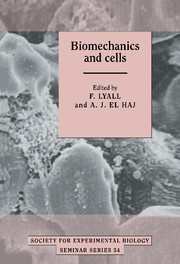Book contents
- Frontmatter
- Contents
- List of contributors
- PART 1 SOFT TISSUE
- Signal transduction pathways in vascular cells exposed to cyclic strain
- Effects of pressure overload on vascular smooth muscle cells
- Effect of increased flow on release of vasoactive substances from vascular endothelial cells
- Modulation of endothelium-derived relaxing factor activity by flow
- Stretch, overload and gene expression in muscle
- Stretch sensitivity in stretch receptor neurones
- Mechanical interactions with plant cells: a selective overview
- Mechanical tensing of cells and chromosome arrangement
- Alterations in gene expression induced by low-frequency, low-intensity electromagnetic fields
- PART 2 HARD TISSUE
- Index
Signal transduction pathways in vascular cells exposed to cyclic strain
Published online by Cambridge University Press: 19 January 2010
- Frontmatter
- Contents
- List of contributors
- PART 1 SOFT TISSUE
- Signal transduction pathways in vascular cells exposed to cyclic strain
- Effects of pressure overload on vascular smooth muscle cells
- Effect of increased flow on release of vasoactive substances from vascular endothelial cells
- Modulation of endothelium-derived relaxing factor activity by flow
- Stretch, overload and gene expression in muscle
- Stretch sensitivity in stretch receptor neurones
- Mechanical interactions with plant cells: a selective overview
- Mechanical tensing of cells and chromosome arrangement
- Alterations in gene expression induced by low-frequency, low-intensity electromagnetic fields
- PART 2 HARD TISSUE
- Index
Summary
The importance of external physical forces in influencing the biology of cells is just being realised. Recent reports demonstrate that exposure of endothelial cells (EC) to a flowing culture media or to repetitive elongation can result in changes in morphology, proliferation and secretion of macromolecules (Dewey et al., 1981; Davies et al., 1984; Frangos, Eskin & McIntire, 1985; Sumpio et al., 1987; Diamond, Eskin & McIntire, 1989; Sumpio & Widmann, 1990; Iba & Sumpio, 1991, 1992). Now, the major impetus in the field is to define the ‘mechanosensor(s)’ on the cells that are sensitive to the different external forces, the coupling intracellular pathways and the subsequent nuclear events which precede the cell response.
Mechanosensors
Cell surface sensors
The cell's plasma membrane, besides serving as a barrier to protect the cell interior, is the site of action and translation of external to internal signals. Although no ‘strain-receptor’ as such has been identified, it is clear that endothelial cells can ‘sense’ changes in pressure and strain. Furthermore, it is likely that this ‘sensor’ is located on the cell surface. The endothelial cell surface consists of multiple projections covered by a thin layer of glycocalyx (consisting mainly of glycoproteins, proteoglycans and derived substances). In an effort to characterise possible cell surface sensors, Suarez & Rubio (1991) perfused isolated guinea pig hearts with concavalin A or heparinase (agents which modify endothelial cell surface glycoproteins) and attenuated both the flow and pressure stretch induced rise in glycolytic flux normally seen in guinea pig hearts, while having no effect on basal glycolytic values.
- Type
- Chapter
- Information
- Biomechanics and Cells , pp. 3 - 22Publisher: Cambridge University PressPrint publication year: 1994



